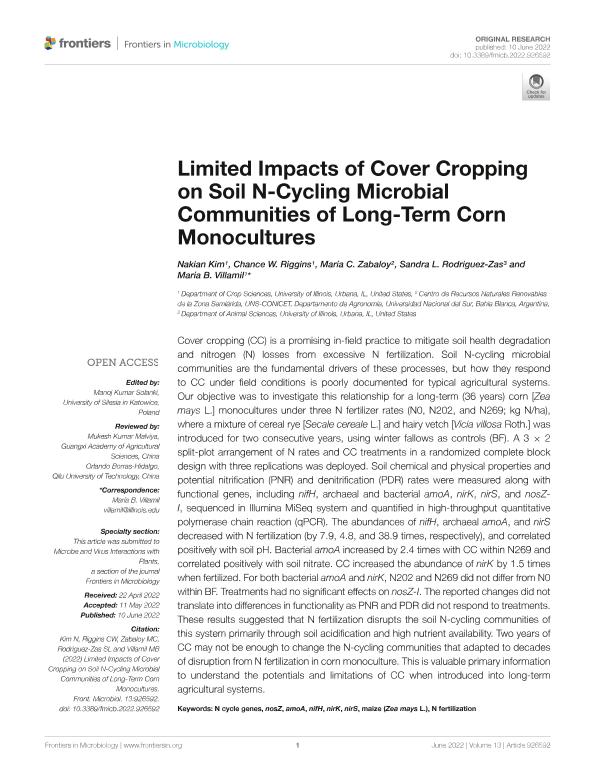Mostrar el registro sencillo del ítem
dc.contributor.author
Kim, Nakian
dc.contributor.author
Riggins, Chance W.
dc.contributor.author
Zabaloy, Maria Celina

dc.contributor.author
Rodriguez Zas, Sandra L.
dc.contributor.author
Villamil, Maria Bonita

dc.date.available
2023-07-25T14:12:08Z
dc.date.issued
2022-06-10
dc.identifier.citation
Kim, Nakian; Riggins, Chance W.; Zabaloy, Maria Celina; Rodriguez Zas, Sandra L.; Villamil, Maria Bonita; Limited Impacts of Cover Cropping on Soil N-Cycling Microbial Communities of Long-Term Corn Monocultures; Frontiers Media; Frontiers in Microbiology; 13; 926592; 10-6-2022; 1-16
dc.identifier.uri
http://hdl.handle.net/11336/205309
dc.description.abstract
Cover cropping (CC) is a promising in-field practice to mitigate soil health degradation and nitrogen (N) losses from excessive N fertilization. Soil N-cycling microbial communities are the fundamental drivers of these processes, but how they respond to CC under field conditions is poorly documented for typical agricultural systems. Our objective was to investigate this relationship for a long-term (36 years) corn [Zea mays L.] monocultures under three N fertilizer rates (N0, N202, and N269; kg N/ha), where a mixture of cereal rye [Secale cereale L.] and hairy vetch [Vicia villosa Roth.] was introduced for two consecutive years, using winter fallows as controls (BF). A 3 × 2 split-plot arrangement of N rates and CC treatments in a randomized complete block design with three replications was deployed. Soil chemical and physical properties and potential nitrification (PNR) and denitrification (PDR) rates were measured along with functional genes, including nifH, archaeal and bacterial amoA, nirK, nirS, and nosZ-I, sequenced in Illumina MiSeq system and quantified in high-throughput quantitative polymerase chain reaction (qPCR). The abundances of nifH, archaeal amoA, and nirS decreased with N fertilization (by 7.9, 4.8, and 38.9 times, respectively), and correlated positively with soil pH. Bacterial amoA increased by 2.4 times with CC within N269 and correlated positively with soil nitrate. CC increased the abundance of nirK by 1.5 times when fertilized. For both bacterial amoA and nirK, N202 and N269 did not differ from N0 within BF. Treatments had no significant effects on nosZ-I. The reported changes did not translate into differences in functionality as PNR and PDR did not respond to treatments. These results suggested that N fertilization disrupts the soil N-cycling communities of this system primarily through soil acidification and high nutrient availability. Two years of CC may not be enough to change the N-cycling communities that adapted to decades of disruption from N fertilization in corn monoculture. This is valuable primary information to understand the potentials and limitations of CC when introduced into long-term agricultural systems.
dc.format
application/pdf
dc.language.iso
eng
dc.publisher
Frontiers Media

dc.rights
info:eu-repo/semantics/openAccess
dc.rights.uri
https://creativecommons.org/licenses/by/2.5/ar/
dc.subject
AMOA
dc.subject
MAIZE (ZEA MAYS L.)
dc.subject
N CYCLE GENES
dc.subject
N FERTILIZATION
dc.subject
NIFH
dc.subject
NIRK
dc.subject
NIRS
dc.subject
NOSZ
dc.subject.classification
Ciencias del Suelo

dc.subject.classification
Agricultura, Silvicultura y Pesca

dc.subject.classification
CIENCIAS AGRÍCOLAS

dc.subject.classification
Biología Celular, Microbiología

dc.subject.classification
Ciencias Biológicas

dc.subject.classification
CIENCIAS NATURALES Y EXACTAS

dc.title
Limited Impacts of Cover Cropping on Soil N-Cycling Microbial Communities of Long-Term Corn Monocultures
dc.type
info:eu-repo/semantics/article
dc.type
info:ar-repo/semantics/artículo
dc.type
info:eu-repo/semantics/publishedVersion
dc.date.updated
2023-07-07T21:36:14Z
dc.identifier.eissn
1664-302X
dc.journal.volume
13
dc.journal.number
926592
dc.journal.pagination
1-16
dc.journal.pais
Suiza

dc.journal.ciudad
Lausana
dc.description.fil
Fil: Kim, Nakian. University of Illinois. Urbana - Champaign; Estados Unidos
dc.description.fil
Fil: Riggins, Chance W.. University of Illinois. Urbana - Champaign; Estados Unidos
dc.description.fil
Fil: Zabaloy, Maria Celina. Consejo Nacional de Investigaciones Científicas y Técnicas. Centro Científico Tecnológico Conicet - Bahía Blanca. Centro de Recursos Naturales Renovables de la Zona Semiárida. Universidad Nacional del Sur. Centro de Recursos Naturales Renovables de la Zona Semiárida; Argentina. Universidad Nacional del Sur. Departamento de Agronomía; Argentina
dc.description.fil
Fil: Rodriguez Zas, Sandra L.. University of Illinois. Urbana - Champaign; Estados Unidos
dc.description.fil
Fil: Villamil, Maria Bonita. University of Illinois. Urbana - Champaign; Estados Unidos. Consejo Nacional de Investigaciones Científicas y Técnicas; Argentina
dc.journal.title
Frontiers in Microbiology
dc.relation.alternativeid
info:eu-repo/semantics/altIdentifier/doi/http://dx.doi.org/10.3389/fmicb.2022.926592
dc.relation.alternativeid
info:eu-repo/semantics/altIdentifier/url/https://www.frontiersin.org/articles/10.3389/fmicb.2022.926592/full
Archivos asociados
